
Architectural Styles and Revivals: Romanesque Revival Public Buildings
(Written by Dr. Les Crocker, UWL Emeritus Professor of Art History)
A more detailed discussion of these buildings can be found in my book Places and Spaces available at all public library branches. A personal copy of this beautiful book can be purchased from the La Crosse County Historical Society or the La Crosse Public Library Archives.
The economic panic of the 1870s had not hurt the rich in La Crosse. Their investments in the logging and lumber industries continued to flourish. Hirschheimer‘s plows and harrows were the standard all over the upper Midwest and into the farmlands of the Dakotas. Several foundries were turning out pumps for wells and sewage, columns and beams for construction, boilers for steam engines and just about anything your imagination could conceive. All the immigrants from Europe were drinking beer. La Crosse was booming, jobs were plentiful, the population was growing.
The Romanesque revival was based on church architecture, mostly in France and Spain, from the period of 950-1100 CE. The name means “like that in Rome” or in the Roman Empire. After the chaos following the collapse of the Roman Empire, the Roman barrel vault reappeared, if it ever really vanished, and larger vaulting in churches appeared. There are great differences in the dates and forms of the buildings in this period. Local or regional styles developed in response to local materials and traditions of worship. Mostly, the Romanesque style is based on religious examples. Few houses of the period remain and examples vary greatly in form, materials, and plans from area to area in Europe.
There were a lot of variations in church design at the time and there are a lot of variations within the revival style. Some are authentic, but by the 1890s the style had become less extreme and the massive walls become more generic.
The Romanesque period was the immediate predecessor of the Gothic period/style and marks a return to the more massive and sophisticated building techniques of the Romans. With the coming of the millennium there was great concern in western Europe for the reappearance of Christ and the end of the world. Catholic churches in Eastern Europe used different calendars and didn’t get as bothered about the date. After 1000 CE, the western Christians were so relieved that the world hadn't ended, that they built even more churches. Derived from Roman buildings, with some elements from the Islamic world, these churches used stone barrel or tunnel vaults to cover the aisles and transepts. It is mostly a religious style since few secular buildings of the time required the vaulting of large spaces.
If Gothic was light in weight and dissolved the wall, then Romanesque was heavy and the mass of the wall became a dominant element. The round arch of the Romans, square towers, windows much smaller than in the Gothic period, thick wall buttresses, but no flying buttresses allowed.
The Romanesque revival is often presented as a more robust reaction to the earlier Gothic Revival, a more solid, even more manly, style. It can also be interpreted as part of the Picturesque styles that developed after the Civil War. Its use in houses produced mixed results; it was best suited to large buildings, such as the Batavian Bank and the McMillan Building in downtown La Crosse and various churches in town.
The La Crosse Public Library, 1888
Finally, in 1888 we got a real library. The building committee chose the design by C.C. Yost of Minneapolis who produced a rather compact brick building with a grand entrance arch very much in keeping with the style and a very military-like two-and-a-half-story tower.
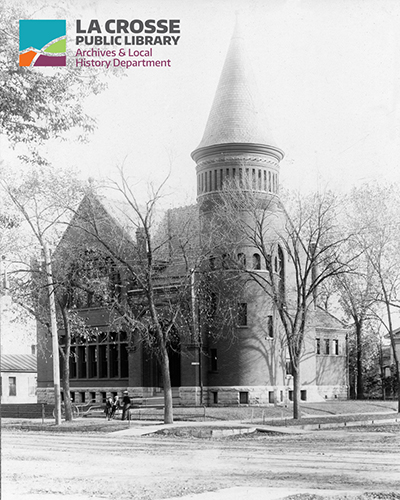
The original La Crosse Public Library before 1909.
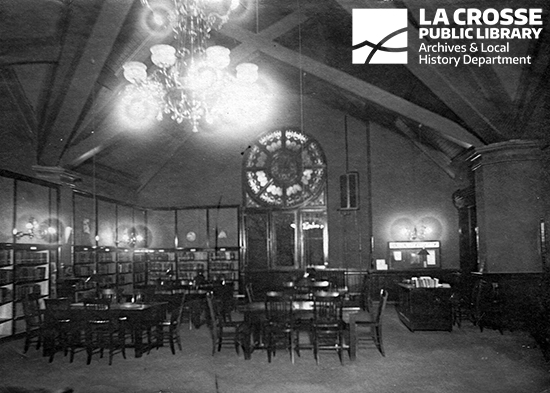
The reading room in the interior uses fantastic scissor trusses to support the roof without interior support walls or columns.
In 1909, an addition was made by Parkinson and Dockendorff, local architects, doubling the interior space of the library. They repeated the large front gable but covered everything, both new and old with a cement stucco that was the wonder material of the early 1900s, supposedly requiring little maintenance and lasting forever. It also caught the soot from the coal burning fireplaces and stoves heating the houses and it covered all the brick detailing on the older building.
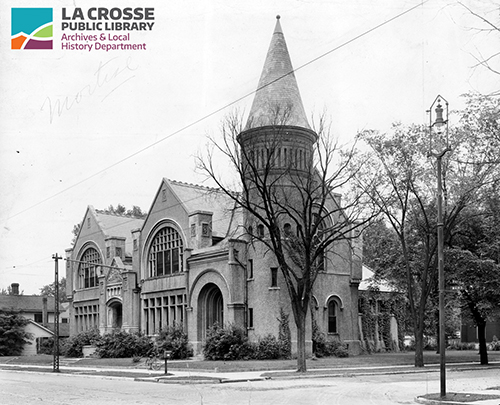
The library after the 1909 addition.
Federal Building, 1889
The new Federal building from 1889 handled all the federal government business in La Crosse, including the post office, the federal court with necessary offices, and offices for customs collection off the river boats. Freret and Wetmore were contract architects who designed buildings for the federal government. Their original design was used in several Midwestern towns.
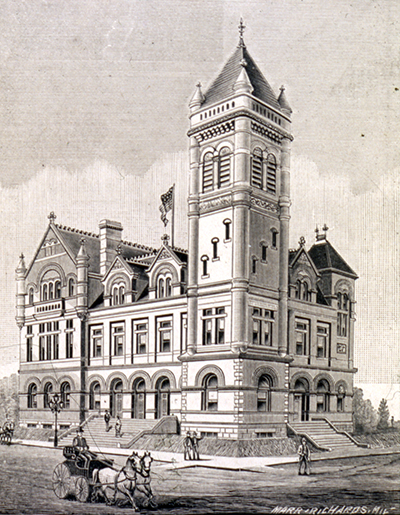
An architectural rendering of the federal building.
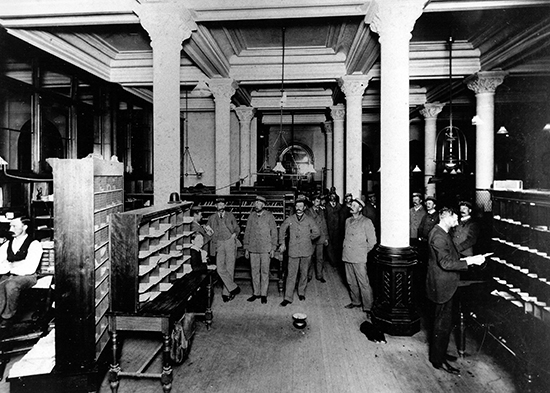
Iron columns, not Romanesque arches, support the ceiling of the sorting room of the post office.
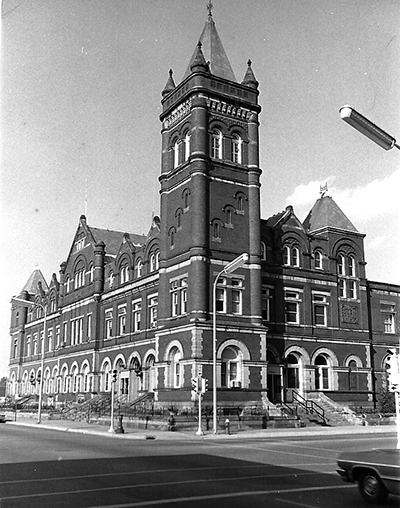
A small addition was made on the rear in 1910 and in 1931 the building was almost doubled in size. 1973 photo by author.
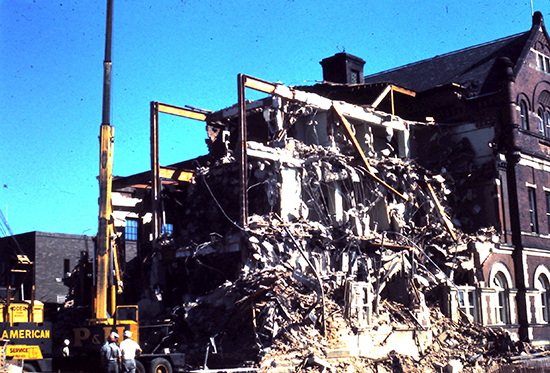
The demolition revealed the steel frame used in the 1931 addition. 1977 photo by author.
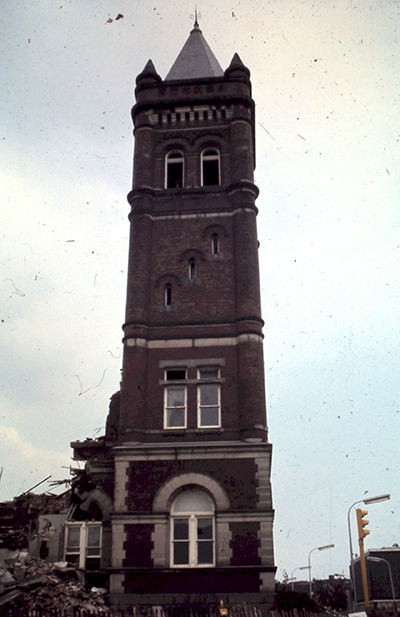
The corner tower was the last part to go and became both a glaring image of destruction and for us preservationist it was the symbol of changes to come. 1977 photo by author.
Two good things came out of the demolition of what was fondly called "the old post office" by many residents. For the first time many people became aware of the losses that La Crosse had sustained. All of its old public buildings had been destroyed and the “modern” replacements weren’t appreciated, regardless of what the architects said. A few of those concerned citizens formed the La Crosse Area Society for Historic Preservation, which later became PAL, and the preservation movement in La Crosse was off and running.
The other good thing about the demolition was that the preservation people discovered that the government had violated its own law requiring a pre-demolition report on the building to be demolished. It wasn’t enough to prevent the demolition, but it provided some leverage against the total demolition. The relief sculptures that had once adorned the exterior were carefully removed by the contractors and built into a memorial wall, along with some other items from the building.
I had been one of the founders of the preservation group and was not looked upon fondly by the city administration that was definitely anti-preservation. Nobody would even take my telephone calls much less discuss other possibilities. With a lack of a pre-demolition report the government had to produce some paper. There were art historians in Madison and Minneapolis, but the government would have to go to Milwaukee to find another architectural historian. Suddenly people smiled at me when I showed up at the work site. The mayor and city planner were polite and we got The Wall as part of the pay-off for not pressing a law suit. At the time there was some discussion about saving the tower, but the new post office was going to be built on that parcel of land regardless of whatever happened. Mixing the old tower into the new design would have been absurd and rather ugly as well.
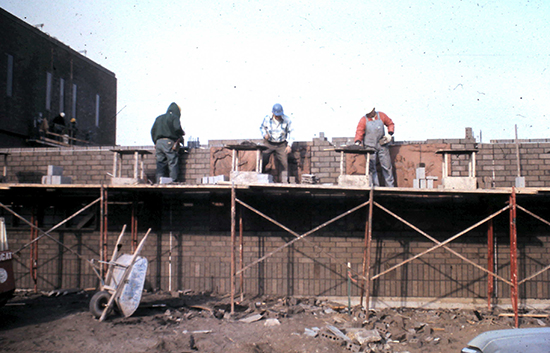
The “Wall” at the new post office/Federal building included terra cotta motifs that were saved from the original building. 1977 photo by author.
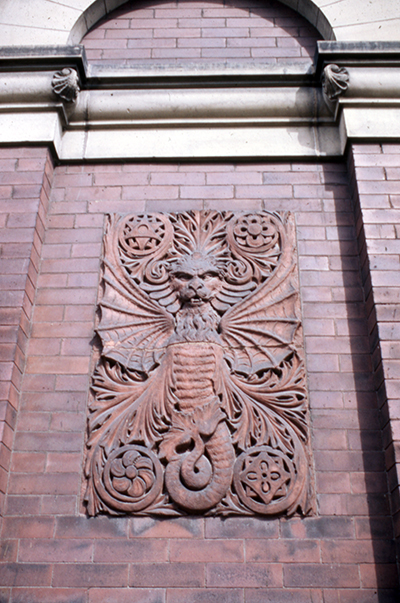
The dragon plaque. Go visit “The Wall” and touch a time when the government included beauty in the list of building specifications. 1977 photo by author.
Third County Jail, 1890
By 1890 the old Egyptian revival jail was not up to the standards required and a new jail was designed by the prison specialist architect from Madison, Allan Conover. Like the City Hall, it has a high stone basement and a multi-level tower. There is a large arch over the entrance and a shorter round tower on the far corner.

The third county jail that once stood on Zeisler Street had the arched windows, round tower, and conical elements typical of the Richardson Romanesque revival architecture.
Second City Hall, 1891
The Second City Hall was built in 1891 to the design of Stoltze & Schick, a local firm.
This brochure from the dedication of the new City Hall shows a dynamic Romanesque revival building in the brick sub-style of central Europe, rather than the stone-walled Romanesque buildings of Spain, eastern France and Italy that inspired H. H. Richardson. The contractor was Joseph Schwalbe, whose family built many of the finer buildings in La Crosse.
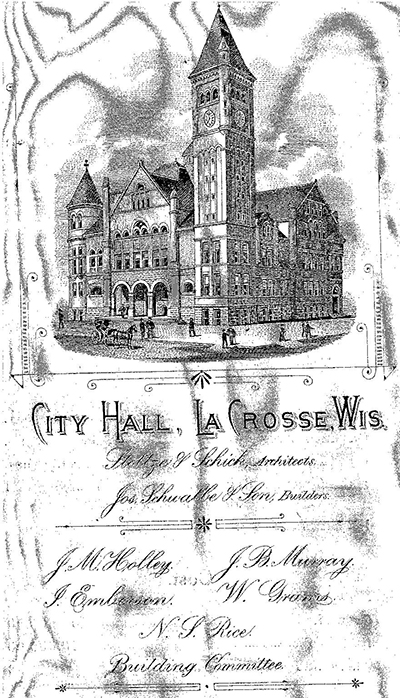
A brochure from the dedication of the second City Hall, features a rendering of the building. Photo courtesy of Laura Schwalbe.
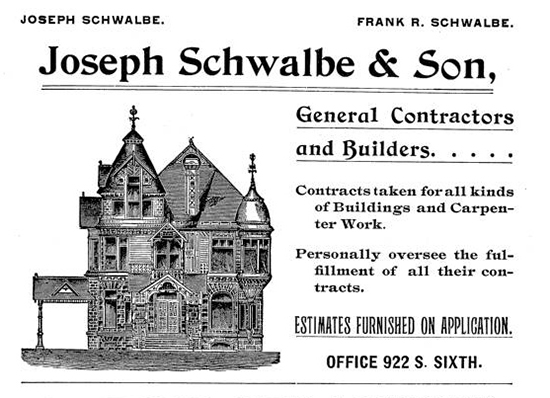
The Schwalbe company had a long history of building La Crosse. The engraving of a house is a standard printer’s image and was not a specific house in La Crosse.
The architects obviously wanted the tower to tower, it is the most obvious feature and once dominated the town skyline. Four tall, thin, round arches fill each side of the tower shaft and a small turret makes up one corner and extends above the roof. The red brick building sat on a limestone basement creating a strong visual contrast. We all know that stone can support a great deal of weight. When we see how much stone it tells us subconsciously that there is a very heavy building above it. Windows are plentiful, but large expanses of wall tell us that this is not a Gothic building with pointed arches, glass walls and flying buttresses. Chimney-like buttresses flank the large gables of the roof, their varied height reminding us that many of the original Romanesque buildings were added to and altered over time.
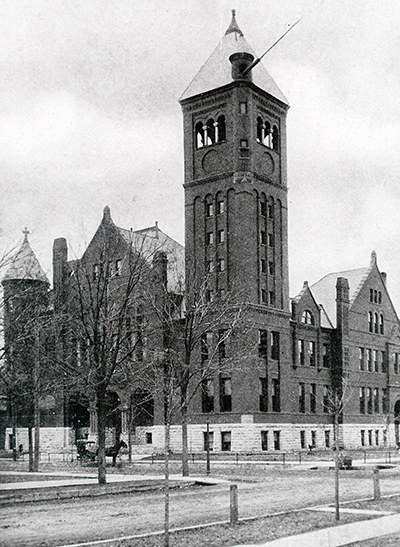
A horse and buggy can be spied at the entrance to the second city hall in this early photo taken from the southeast corner of 6th & State Streets.
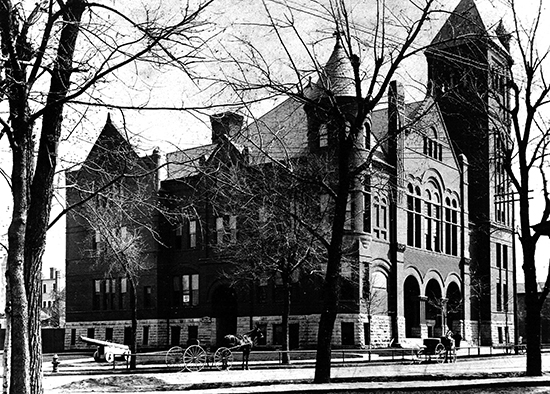
The west side also had a corner tower, but round and not nearly as high. The three arched main entrance was on State street with a complex mass of windows above it.

This view is from 1969, just prior to the demolition. The building is dirty from the soot filled air from coal burning stoves, but it does show all the decorative brickwork that caught the soot. 1969 photo by author.

A close view of the State street side shows the concentric arches as well as the corbelled brickwork beneath the tower windows. The tall tower on the far corner had already lost its top. 1968 photo by author.

Terra-cotta tiles fill the space above the entrance arches. A cluster of six columns support one large capital raised carving. Look at the way the shaped bricks create shadow lines that emphasize the curves of the arches. 1968 photo by author.
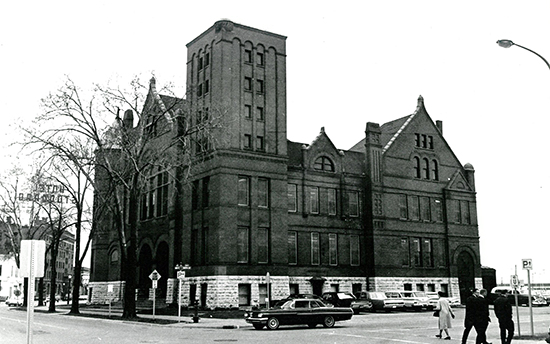
This photo from the late 1950s shows that the tower top level had already been removed. Old buildings sometimes require extra maintenance. The tower roof was probably leaking and someone said “There's no useable space up there, let’s just take it off." Few people really cared about old buildings.
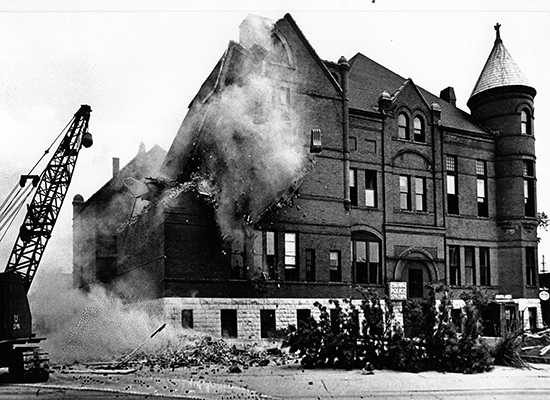
The demolition begins.
City Pumping Station, 1895
The King Street pumping station was designed in 1895 by John Adams Cole from Chicago. Cole was a recognized sanitary engineer in the late nineteenth century. In this instance, the city hired the best man available to upgrade the city water system.
Public interest in the city’s water system was considerable. Medical research had proven the danger of contaminated back yard wells, but the city needed a larger pump system to maintain water pressure over a larger area as the city expanded
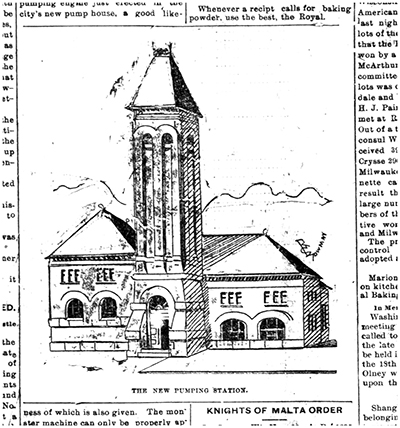
This sketch printed in the November 16, 1885 edition of the La Crosse Daily Press shows the new building.
The tall, thin arches of the tower echo those on the city hall tower. The round arch of the entrance is repeated in the windows to the left and the doors to the right of the tower. It was a very handsome building housing a prosaic function. Beauty in their surroundings was very important to people who had much less visual stimulus than we do.
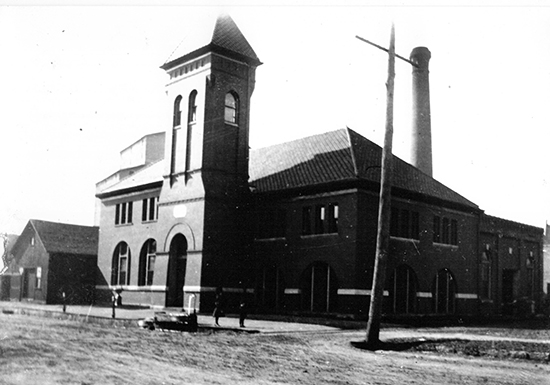
Two faint figures stand beside the watering trough and look at the new pumping station that sits on a dirt street.
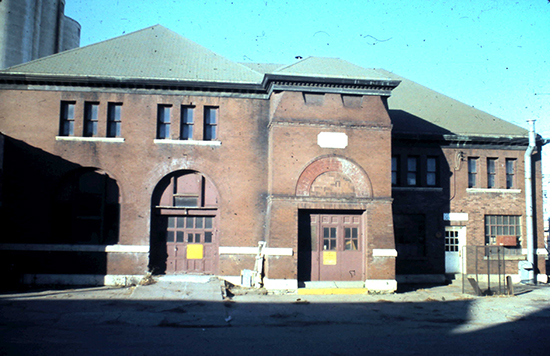
This was the prize in 1976 won by the preservationists: a much altered, run down old building.
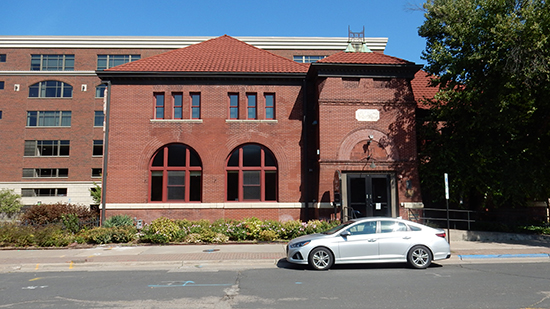
The pump house has been cleaned up. 2023 photo by author.
The Pump House, as it is now called, has become a venue for the creative arts in La Crosse and that is good. However, its present appearance is only a shadow of what this commonplace building once was. The tower was removed, arches closed. Its survival is not a triumph of preservation, but part of the deal over the Federal Building demolition mess-up. It was a pay-off to make the preservationist go away.
This mutilated building is a reminder that a continuous search for something new while destroying the past is seldom beneficial to people or communities.
Third County Courthouse, 1904
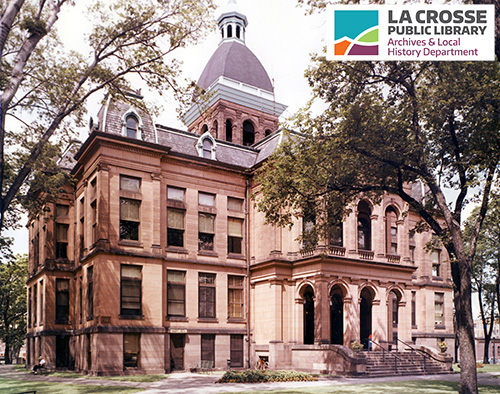
The Third County Courthouse, built in 1904 marked the end of the use of Romanesque revival in public buildings in La Crosse.
The Third County Courthouse from 1904 was not Romanesque revival. Gustave Schick, of Schick & Roth, abandoned the Romanesque and used a more English Renaissance style here, signifying that even in the Midwest the Romanesque revival style was over.
Our look at this revival in La Crosse, however, is not. Next week-- the style as it is represented in our commercial buildings.
Other entries in this series
Architectural Styles and Revivals
Architectural Styles and Revivals: The Greek and Roman Revivals
Architectural Styles and Revivals: The Gothic Revival
Architectural Styles and Revivals: The Exotic Revival
Architectural Styles and Revivals: The Italianate Style
Architectural Styles and Revivals: The Second Empire Style
Architectural Styles and Revivals: The Queen Anne Style
Architectural Styles and Revivals: The Colonial Revival
Architectural Styles and Revivals: Romanesque Revival Public Buildings
Architectural Styles and Revivals: Romanesque Revival Commercial Buildings
Architectural Styles and Revivals: Romanesque Revival Homes
Architectural Styles and Revivals: Religious Romanesque
